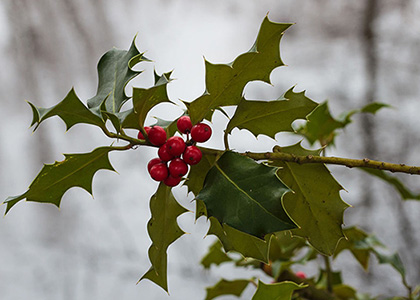
In ancient European cultures, the holly tree symbolized the waning sun commencing with the summer solstice and the oak tree symbolized the waxing sun commencing with the winter solstice. The Druids believed holly’s evergreen nature made it sacred and that it remained green throughout winter to keep the earth beautiful at a time when deciduous trees shed their leaves. Holly was used for decoration throughout homes, hanging boughs of it over entrances to peoples’ homes or as wreaths of holly that were hung on doors. Placing a ring of holly on doors originated in Ireland, though holly wreaths were also given as gifts by the Romans during Saturnalia. Holly, green with red berries, was one of the few plants still beautiful at this time of year. It gave the poor a means of decorating their dwellings. Decorating one’s home with holly was believed to bring protection and good luck to the inhabitants in the coming year. The “prickles” on the holly leaves were also thought to snag evil spirits before they could enter the home.
Holly legends abound. Holly was included in the evergreens brought in during the winter to provide safe haven for faeries and other nature spirits; but it was especially prized because of its shiny leaves and its ability to bear fruit in winter. Some people used holly bark to make a syrup to cure coughs; others hung it over their beds to produce good dreams. Holly was a popular Saturnalia gift among the Romans (the Roman celebration at the winter solstice honoring their god, Saturn) who later brought holly to England, where it was also considered sacred. Christians later adapted the legends; and during some periods of history, it was called the “holy” tree. Some say that the sharp leaves symbolized the crown of thorns and the red berries symbolized the blood of Christ. Legend says that hollies sprang forth wherever He walked.